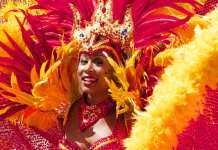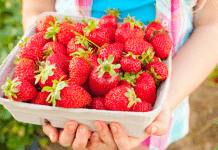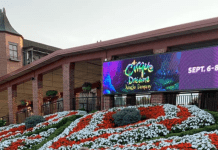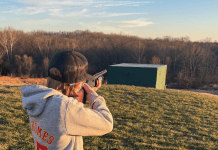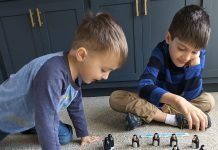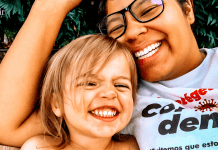Our team, just like many of you, has been struggling to find the words to explain the news and wondering how we can be part of the anti-racism effort – no matter what our family looks like. We don’t claim to have the answers, but we know sometimes it helps to hear what other moms are thinking. This post is aimed to start a conversation, a sharing of resources and ultimately more listening, learning and doing better.
Hannah Fox
For Patch (age 6), I purchased the book called Sulwe, by Lupita Nyong’o. After reading it
we talked about a) the beauty of skin in every color b) scenarios: what to do if…someone says something unkind about skin color its our job to say something….if someone feels left out bc they aren’t the ‘same’ that we invite them in c) He is also listening to audio books on the Epic app about fairy tales from Africa. “Anansi and the spider” “Anansi and the pot of beans” For Peter (age 4) & Natalie (age 1.5) I’m gathering our books that have black/hispanic/asian represented, to make sure they are in the rotation that my kids are actually reading. I haven’t talked explicitly about it. I’m thinking about ordering Natalie a baby doll with dark skin, but not sure if thats a helpful exposure.
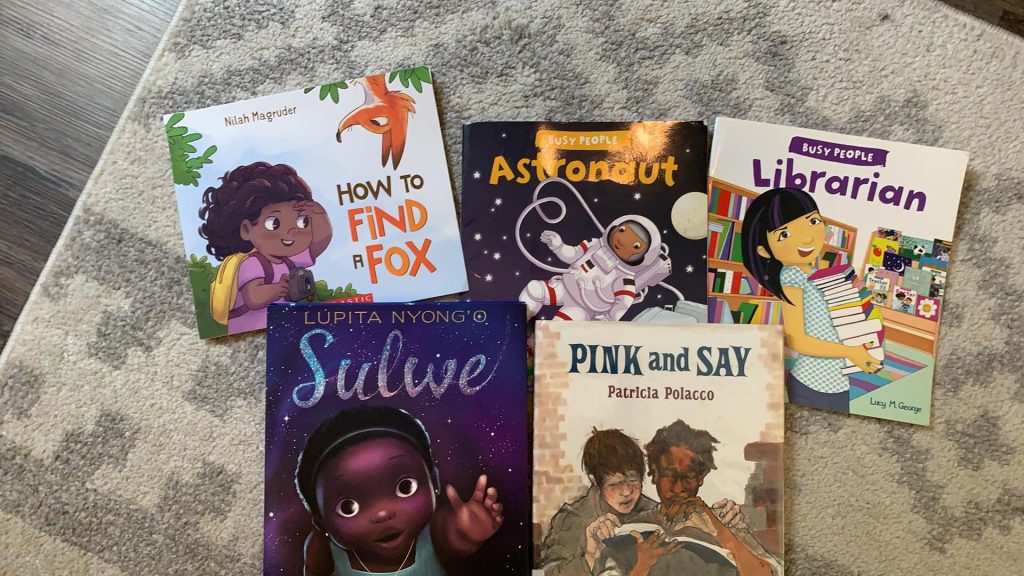 LaToi-ya Camareno
LaToi-ya Camareno
As you know we are a mixed-race family. We always have and always will teach your children that no matter what you look like on the outside everybody is human and everybody deserves to be treated fairly. On the other hand since we are people of color. We have to teach our children that there are parts of this world and people in this world that will always treat them different. We try to teach them that they need to be aware of the situation that they are in so that they can act accordingly. It’s a little sad that this is still a thing in our world, however we feel that if we raise our children to be good productive citizens we are giving them the best Head start we can. When people ask us, what can we do to help? We just tell them to lead by example. Children of the product of their surroundings so if we want our future generations to be better we have to be better.
You may not have a lot of friends of different ethnicities you may live in a neighborhood that doesn’t have a lot of racial diversity, find a way to engage in the community with your children. May it be volunteering at a local food bank, or volunteering at the Special Olympics. Maybe this means finding a way to put yourself out of your own comfort zone, get your kids involved and sports groups that may have a better racial diversity. Introducing children to all different types of people in various different situations this is how we breed a better future for our country. This is just how we feel and this is what we believe to be true no matter what the color of your skin is
White kids need to be friends with Black kids, Black kids need to be friends with Hispanics, the list goes on. We live in the greatest country in the world. Racial diversity in this country is not going anywhere, and it is very, very important that our children can learn how to look past what somebody looks like.
Jen Christensen
Every year I talk with my kindergarteners about Martin Luther King, Jr, – the basics, who he was, what he did for our country, why we have a holiday for him. I have to admit I am always pleasantly surprised at how my students react – thankfully, most have been taught that the color of your skin doesn’t matter and we are all equal in God’s eyes. They are usually so shocked that black kids had to go to different schools, or couldn’t play with white kids. Their innocent hearts can’t understand it and think it’s the craziest thing they ever heard. And to help them understand more, I say it’s like me telling the kids with brown eyes can’t play with the kids with blue eyes. That makes it more relatable for some reason. So, I really have no words of wisdom, except that I am always amazed at how they just think it’s so crazy that people are treated differently because of their skin. I find solace in that every year, if only for a day.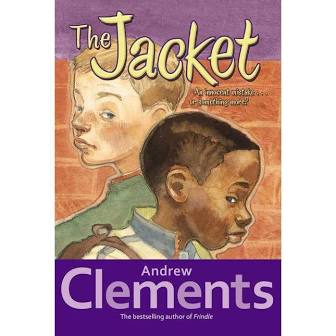
Will also recently read The Jacket, by Andrew Clements. He’s one of my favorite children’s author. We stumbled on this book randomly, as I didn’t know anything about it. The main character is a white middle school student who doesn’t feel he has discriminatory tendencies but is forced to rethink his stance when he accuses a black student of taking his missing jacket. The book is excellent and Will loved it. He says it’s one of the best books he ever read, and he talked about how sad it made him feel when the boy was accused unfairly. This would be a great book for fifth grade and up.
Beth Dusin
I find myself the mother of two teenagers, one headed to college in the fall. I told my Manhattan-bound kid today that one of my biggest regrets as a parent was not talking more specifically about race and justice. When my kids were littler my message was one of inclusion. We talked about different, not better or worse. We had conversations about the many ways families are formed—and that love is love is love. I taught in words and
example that all people are deserving of respect and kindness. Our family follows the Christian tradition, and so our dialogue was filled with the loving, affirming example of Jesus.
Now that my boys are older, we are talking about race in different ways. We talk about privilege and dog-whistle politics and misogyny. We talk about the politicians their friends support and how to stand up for your own beliefs. I watched episodes of #black AF, The Shop, and More than an Athlete with my older son this spring, and we talked about our own experiences. Now we are talking about who he will vote for in November. I’m trying to find the right balance now between talking and listening, teaching and learning.
Denise Mersmann
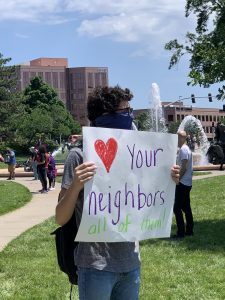 It predated me and I am very concerned it will still be a problem long after I’m gone. And so many things about that sicken me. I’m white and my family is white so I can’t even begin to understand what POC experience.
It predated me and I am very concerned it will still be a problem long after I’m gone. And so many things about that sicken me. I’m white and my family is white so I can’t even begin to understand what POC experience.Lauren French
This week is one of those weeks that has made me feel severely underqualified in the parenting department. My (white) kids are still very little—my oldest hasn’t had his third birthday yet and my youngest just turned 7 months old. They are both in a pretty diverse daycare (or at least they were, before COVID), but this week has opened my eyes to the fact that I need to take more intentional steps to make sure they grow up with an appropriate understanding of race and diversity, and have direct conversations with them about this topic. Admittedly, I am floundering on where to start, but after talking with some friends and reading through some parenting resources on race, I have started to take some baby steps.
The first (small) thing I did was download this 20-minute NPR podcast about how to talk to young children about race. I popped in my earbud and went on a stroller walk with my daughter while I listened. I highly recommend it, as they’ve got some great tips for talking with young children about race in an age-appropriate way. I’ll be listening again so that I can really absorb some of the ideas and advice, and then implement them in my own home.
The second (small) thing I did was order a book about race. I chose All Are Welcome and ordered it from Amazon. Currently, almost all of our books are about animals, so this next year I am going to focus on adding books to our library that include diverse characters and themes.
I am planning to continue tackling this piece of parenting in bite-size chunks. I definitely feel like I don’t know what I’m doing, but I am going to try my hardest to lay this important foundation for my kids.
Valerie Stark
Our son is almost 2, so he still hasn’t grasped the concept of colors in his crayon box, let alone the deep social fractures hurting people of color in our country and across the world. But that doesn’t mean we aren’t keenly aware of our responsibility to raise kind, empathetic children who use their privilege to speak up against injustice. When I was growing up in my rural community that was 99% white, there were moments when I was uncomfortable by derogatory comments I knew were wrong…but I didn’t speak up nearly enough, and I regret it. I wrongly thought that because there were no POC in the community, let alone the room, there was no one to protect—that it was enough to not participate and ignore the hate. And then our Homecoming photos were taken in front of a confederate flag by a photographer who was also a Black man.
I’d like to say that this was my chance to finally verbalize that something was wrong, to try and protect a person in the room, but in those photos my mouth is shut in a smile. That language and those situations have gone unchecked because people like me were too afraid or preoccupied or didn’t think it was important enough to say something. Now—with the ability to block people on social media and shut out voices against oppression—the spiral of silence has tightened. There isn’t a way back into many of those rooms for me. I don’t want a situation where my son is sick with wishing he had done better, too…that he had better protected people both in and out of the room. What that looks like for us with a toddler: a diversified bookshelf (this podcast has some great resources), using more than just the peach in the Crayola Colors of the World skin tone crayons, and doing the work ourselves to learn how to be better allies.
Sarah McGinnity
We have tried to speak candidly with our kids and not shield them from uncomfortable issues. We showed our oldest (age 8) pictures (but not the video) of George Floyd’s death. We talked about how my husband and I have gotten pulled over by police for minor offenses, and we didn’t worry about anything more than having to pay money. And for people with Black skin, the fear is much greater and very real. We’ve showed pictures of the riots and explained that people are angry and they have tried expressing themselves in many different ways for decades and decades and nothing is changed. For our younger two, we’ve tried to include books and dolls that show different kinds of people. Our favorite book: Not My Idea by Anastasia Higginbotham.
Our biggest focus, though, is to grow ourselves. To seek out media, books, podcasts and people that challenge our privileged thinking and humble ourselves in accepting the ways we fail to speak and act with anti-racism perspectives because of our White privilege. We try to listen when we can’t understand. We have tried to intentionally attend events, invest in friendships and frequent businesses and attractions where we can interact with people who look different than us. Our ultimate goal is that our kids (and us) see people of color as our neighbors and friends that we walk with in our daily life.



